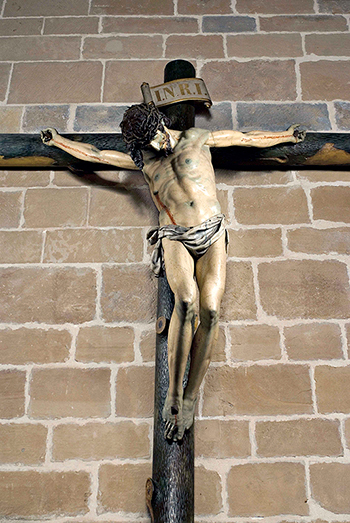The Romanist sculptor Juan de Anchieta
By Pedro Luis Echeverría Goñi
|
|
MAIN ALTARPIECE OF THE PARISH CHURCH OF SANTA MARÍA DE CÁSEDA |
|
|
|
|
|
|
|
|
|

|
|

|
|

|
|

|
Crucified Christ of the Cathedral of Pamplona
It is, in the words of Concepción García Gainza, not only the best Christ of Juan de Anchieta, but one of the most successful of the Hispanic Renaissance sculpture. The master was a specialist in this iconography, as he has left us a dozen excellent images, half of which are in Navarre. Although most of them were not conceived for processions, he is considered a precursor of the Baroque Crucifixions of Holy Week. Although we have several documentary testimonies of his collaborators, who in 1579 refer to a work that he had just made in the cathedral for 100 ducats, and a later inventory that quotation, together with Saint Jerome, as "makings" of Anchieta, it is the inimitable characteristics of the work itself that give away its author, who must have made it between 1577 and 1578. We could describe this Christ as a 'pilgrim', due to its itinerancy through different parts of the cathedral, which added to its name, such as the Barbazana chapel -its first destination-, near the cloister where it was buried, the trasaltar in the 19th century, the ambulatory and its present location, in the chapel of San Juan Bautista. As chance would have it, this devotional work is located today in the cathedral parish where he was a parishioner.
The origin of this crucified Christ is to be found in Astorga, where he worked under the orders of Gaspar Becerra on the main altarpiece of the cathedral. Here he must have been familiar with Michelangelo's drawings, such as the one in the British Museum, which inspired him, the treatise Anatomy by Valverde de Amusco, illustrated by Becerra, and the Crucified Christ of Calvary, the first among the Romanists. It has a size close to life size and a wide concession to the nude, only interrupted by a cloth of purity, reduced to a horizontal strip. Let us remember that in Michelangelo's Neoplatonic thought the nude is allusive to virtue and here it is applied to God made man for our salvation. With it the characteristics of a prototype are fixed, which will be followed by a high issue of replicas throughout Navarre until the mid-seventeenth century. It presents us with a dead Christ with his head collapsed to his right on his chest, leaving hanging locks of his hair and his face hidden, unless we adopt a point of view from the bottom up. On his triangular face we sample an aquiline nose, half-open mouth and forked beard. The double interlaced crown of thorns is carved, as if it were nailed, which differentiates it from the baroque hairpieces. The body adopts a characteristic mannerist camber with the advancement of the left shoulder and the contraposition of the arms. It follows the iconography of three nails with the right foot mounted on the left and the hands contracted by the pressure of the nails.
Made of walnut wood, it has all the characteristics of classical marble statuary, resembling representations of gods and heroes of Antiquity. It fits perfectly to the ideal of devotional image of the Counter-Reformation for representing the dead Christ as the culmination of the redemption of the human race. To the rigor achieved in the imitation of the Anatomy with bones, muscles, tendons and veins, is added a contemporary polished incarnation that has left us that ivory color and the minimal apparatus of blood, located in the streaks that start from the nails or the drops that slide down the forehead. An Italian characteristic is the sensation of the softness of the flesh and skin with purplish-gray bruises in those areas of the body most subjected to the blows during the previous punishments he suffered at the hands of the "sayones".
CABEZUDO ASTRAIN, J., "Church of Santa María de Tafalla", Príncipe de Viana, 67-68 (1957), pp. 426-431.
CAMÓN AZNAR, J., El escultor Juan de Anchieta, San Sebastián, Diputación Foral de Guipúzcoa, 1943.
ECHEVERRÍA GOÑI, P. L. and VÉLEZ CHAURRI, J. J., "López de Gámiz and Anchieta compared. Las claves del Romanismo norteño", Príncipe de Viana, 185 (1988), pp. 477-534.
GARCÍA GAINZA, M.ª C., "El retablo de Añorbe y el arte de la Contrarreforma", in La recuperación de un patrimonio. El retablo mayor de Añorbe, Pamplona, Caja de Ahorros de Navarra, 1995, pp. 4-18.
GARCÍA GAINZA, M.ª C., Juan de Anchieta, sculptor of the Renaissance, Madrid, Fundación Arte Hispánico, 2008.
GARCÍA GAINZA, M.ª C., La escultura romanista en Navarra. Disciples and followers of Juan de Anchieta, 2nd ed., Pamplona, Government of Navarra, 1982.
GOYENECHE VENTURA, M.ª T., "La obra de Juan de Anchieta en la iglesia parroquial de Santa María de Cáseda (Navarra)", Príncipe de Viana, 185 (1988), pp. 535-562.
TARIFA CASTILLA, M.ª J., "Los modelos y figuras del escultor romanista Juan de Anchieta", in Fernández Gracia, R. (coord..), Pvlchrvm Scripta varia in honorem M.ª Concepción García Gainza, Pamplona, Gobierno de Navarra-Universidad de Navarra, 2011, pp. 782-790.
VASALLO TORANZO, L., Juan de Anchieta. Aprendiz y oficial de escultura en Castilla (1551-1571), Valladolid, Universidad de Valladolid, Secretariado de Publicaciones e exchange publishing house , 2012.






